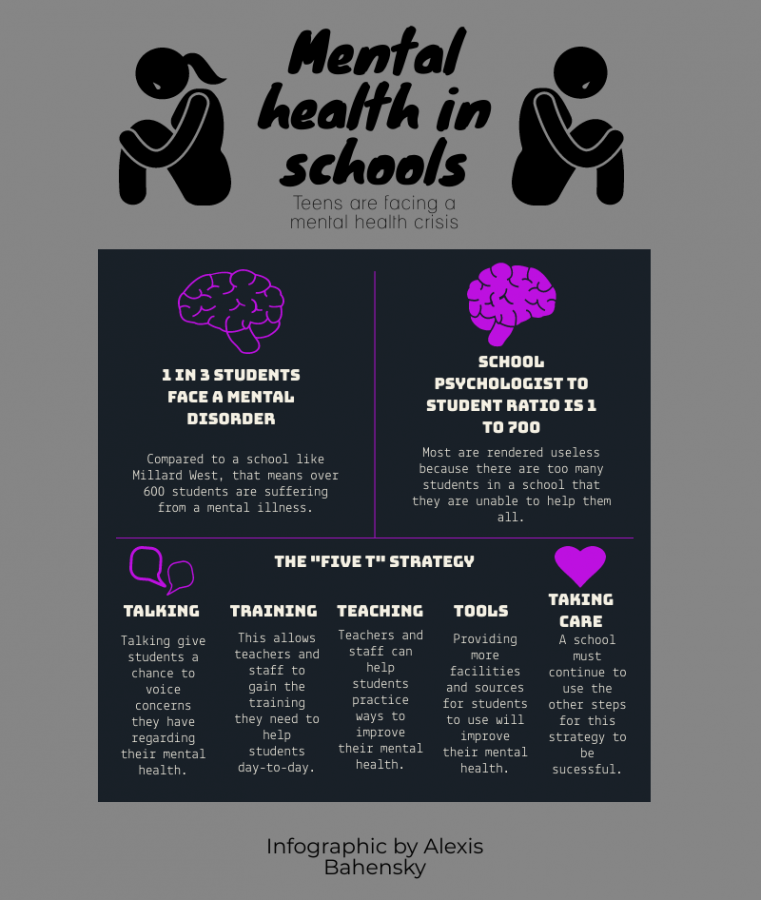The true pandemic amongst teens
How schools handle the mental health of their students must change
Infographic courtesy of Alexis Bahensky
Schools need to create better strategies to deal with teens mental health to help slow the rising cases of mental illnesses in teens.
December 9, 2021
Our generation is facing a mental health crisis. While every generation faces these problems, it is especially evident in Gen Z. The reason behind this, of course, is none other than what students dread the most: school. How schools handle the mental health of their students is a serious problem that must be resolved.
Everyone struggles with mental health issues from time to time, yet it seems that teens nowadays struggle the most. According to the Center for Disease Control (CDC), one in three students face some sort of mental health issue. Not really a significant ratio, as most would put it. Yes, this may only be one-third of a student population, but this can be a significant number when applied to a large school district, such as Millard. The district contains many schools with over 500 students per school. Millard West alone has over 2000 students. This means at least 600 students are having mental health issues, quite a significant number and it isn’t improving.
Schools need to do better. How the administration handles mental health now isn’t cutting it. I won’t say that they aren’t trying, they are; however, facilities and resources need to be greatly improved until this new pandemic is fixed.
One way schools have attempted to handle the situation is by hiring school psychologists. While this is a step toward improvement, there are still problems to solve before this solution shows progress. The recommended ratio of students for a single school psychologist is no more than 700 students, including other needed services along with them. Millard West’s current student population rests at 2,516 students. This is over three times the ratio. Having a school psychologist is ultimately rendered useless if the recommended ratio isn’t met. This diminishes the time a student will be able to spend with the psychologist, meaning they aren’t getting the help they need and deserve.
To help this, we need to hire more psychologists for students to work with. Yes, we have school counselors that would be able to help with the workload; however, these psychologists are specially trained to help students in a mental health crisis. Counselors are there to help with academic questions; they are not the ones responsible for the mental health of students which is why, most of the time, they provide little help in those situations. They don’t have the same education and training as psychologists. If only West, along with other schools, hired more psychologists to accommodate for the number of students, more would use this resource provided and get the true help needed.
Classes are also provided to teach students how to handle their mental health — somewhat. Most schools contain classes that teach basic psychology, which includes mental health issues and how to help deal with them; however, they don’t specifically teach students how to handle their own problems individually. Students may have the same underlying mental health condition but different reasons for having it. Including these classes in school, curriculums would be very beneficial to students.
A curriculum that would show results would be the “five T strategies” which include talking, training, teaching, tools and taking care. This would not only benefit students, but teachers as well.
The talking aspect will of course teach students that they can be open about their situation. They don’t have to keep it in and deal with their problems themselves. Instead, they could talk to someone, such as a teacher or other trusted adult. This leads to training. Teachers now are not very well equipped to handle mental health crisis situations. They aren’t necessarily taught how to help when a student goes into a mental health crisis as it isn’t usually needed to acquire the job. However, if teachers are better prepared, it will only provide better results for students. Teaching would then be provided to students through those newly trained teachers. They would be able to help students handle their own mental health crisis situations so they don’t have to totally rely on school resources all the time. Tools were covered when talking about adding more school psychologists. As for taking care, this goes for teachers and students alike. Schools should add every other part of the five T strategy to ensure the care for everyone in their building.
There are so many ways to improve the mental health of students within a school, but providing more resources such as school psychologists and classes to teach the five T strategies is the first step. They are very easy to implement if schools just took the time and collected the funds to do so. This new epidemic can be stopped, schools just need to put in the time and effort to do so.







